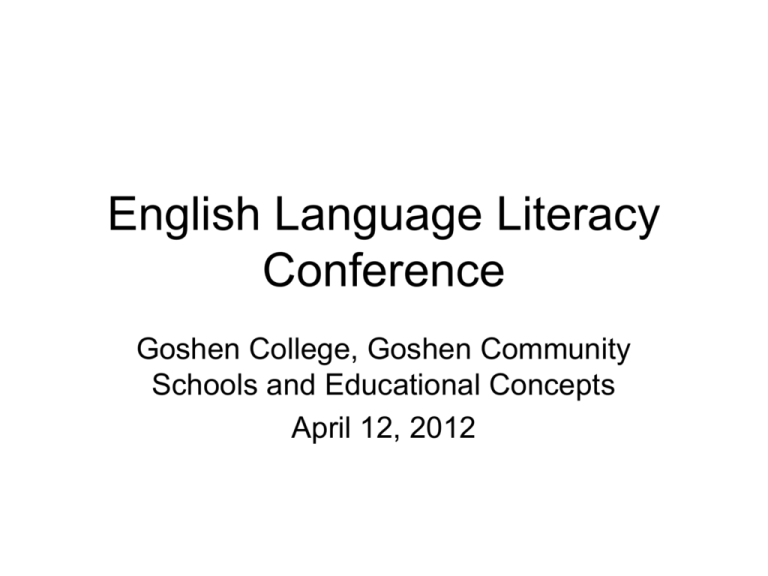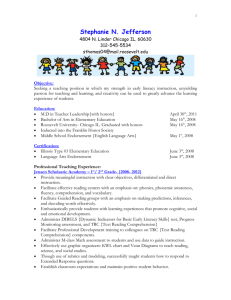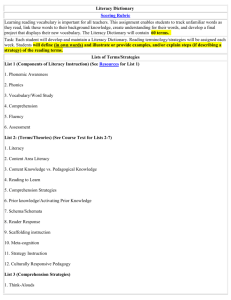English Language Literacy Conference
advertisement

English Language Literacy Conference Goshen College, Goshen Community Schools and Educational Concepts April 12, 2012 Getting started • Education is a journey not a destination but there are milestones along the way. • The work is never done; but there are those from whom we have received the work, and those with whom we share the work, and those who will continue the work when we no longer can. • “It may be that when we no longer know what to do, we have come to our real work, and when we no longer know which way to go, we have begun our real journey.” Wendell Berry (born 1934)Farmer, writer, academic • • • • • Expectations for today: Polishers and keepers Implications and applications Sowing seeds and transplanting ideas Filling the empty places for re-growth and rebirth • Energize and equip all of us for tomorrow, next week, next month and next year. • Conference goals – • Answer questions about EL and literacy • Look at what data and research is telling us about EL and literacy • Implications for how we craft learning opportunities for EL students • Application for instructional practices in the break out sessions. • Questions??? Do students have to learn to speak before they can read and write? • What are reasonable benchmarks for my level ___ student at ___ time of the year? • Why can my students “read” 3 levels above their comprehension level? • How do we move students to higher levels of literacy? • How do Indiana State standards and EL standards and Common Core State Standards all fit together? • What we know about literacy in general – 5 key components - phonemic awareness, phonics, fluency, vocabulary, and text comprehension identified by the National Reading Panel (NICHD, 2000) • What does that mean for EL. Instruction that provides substantial coverage in the key components has clear benefits for languageminority students. Diane August and Tim Shanahan 2006 • Instruction in the key components of reading is necessary—but not sufficient—for teaching language-minority students to read and write proficiently in English. Oral proficiency in English is critical as well—but student performance suggests that it is often overlooked in instruction. • Word-level skills in literacy—such as decoding, word recognition and spelling—are often taught well enough to allow language-minority students to attain levels of performance equal to those of native English speakers. • This is not the case for text-level skills—reading comprehension and writing. • The difference is Oral Language Proficiency. • Not a strong predictor of word level skills. • POP – cvc word. P…O…P POP • Mario = Ma… ri…o • Ma, La, Va, Ca, Ta, Ra, • Vaca, Mata, Rata. • La vaca mata la rata. • “I like to drink pop and pop balloons,” said Pop. • Well-developed oral proficiency in English is associated with English reading comprehension and writing skills for EL students. • Specifically, English vocabulary knowledge, listening comprehension, syntactic skills, and the ability to handle meta linguistic aspects of language, such as providing definitions of words, are linked to English reading and writing proficiency. • SO WHAT????? • It is not enough to teach language-minority students reading skills alone. Extensive oral English development must be incorporated into successful literacy instruction. • Literacy programs that provide instructional support of oral language development in English, aligned with high-quality literacy instruction are the most successful. • Vocabulary and background knowledge, should be targeted intensively. • Claire E White presentation Create conference, October 4, 2009 – Tier 2 or 3. • Greater language demands of secondary texts, particularly vocabulary, that occurs across content area texts. • Unfamiliarity with specific academic vocabulary - the words necessary to learn and talk about academic subjects (analyze, refer, claim, develop, interpret) • Additional burden of acquiring English and mastering grade level content. • Proficiency can be obscured by the types of activities and questions. • EL can seem proficient if questions or activities simply require them to “pluck from the text” a satisfactory response. • Background knowledge, vocabulary and real comprehension must be checked by more meaningful interactions with texts. • Fast-paced, low-level question/answer routines are the norm in most classrooms serving EL. (Zang, Anderson, &Nguyen-Jahiel, 2009) • We need to have EL talk more in ways that engage them. • How: Literature circles, Instructional conversations, Collaborative reasoning, Book Clubs can be used. • Zhang, Anderson, and Ngyuyen-Jahiel 2009 found that over a 4 week period, 8 discussions in an open format discussion approach resulted in improvements on listening and reading comprehension measures as well as in the production of more coherent narratives with more diverse vocabulary and text evidence. • Doubled the EL students’ rate of talk. • IREAD Conferences. • How do we teach vocabulary and for what purposes? • Remember that vocabulary has 2 parts Label and Concept. • Isabel Beck's three tiers: • Tier One: Basic words that rarely require instructional focus (door, house, book). • Tier Two: Words that appear with high frequency, across a variety of domains, and are crucial when using mature, academic language (coincidence, reluctant, analysis). • Tier Three: Frequency of these words is quite low and often limited to specific fields of study (isotope, Reconstruction, Buddhism). • For EL students, there are 4 tiers. Calderon, et al. 2003 • Tier 1 is basically the same as Becks, Words students know in native language and just need an English label, cognates, etc. • Tier 2 – More troublesome: Tier 1 words for NE speakers, high frequency but have multiple meanings, e.g. pop, storm, point, Students mostly do not make connections between different contexts. • Tier 3 – Becks tier 2 words – not cognates – difficult to recognize immediately e.g. performed, avoidance • Tier 4 – limited domain, low frequency words e.g. chlorophyll, lathe, alliteration. • Tier 2 example – Point • He sharpened the point of the knife (sharp end of) • He wasn’t sure of the point of the story (purpose of) • He made an interesting point in his argument. (an important detail) • He walked to a point 10 ft. from the outhouse. (specific location) • He made a point for his team (score) for • The decimal point is in the wrong place (a is mathematical punctuation) • Record the color of the solution at each point. (step of a process) • Two additional areas to touch on – CCSS and family involvement • CCSS will require the teaching of literacy by all teachers in all content areas including Speaking and listening skills. • An integrated model of literacy - Although the Standards are divided into Reading, Writing, Speaking and Listening, and Language strands for conceptual clarity, the processes of communication are closely connected, as reflected throughout this document. For example, Writing standard 9 requires that students be able to write about what they read. Likewise, Speaking and Listening standard 4 sets the expectation that students will share findings from their research. • Grade 3 Speaking and Listening, Comprehension and collaboration. ELA & Literacy in History/Social Studies, Science and Technical subjects. • 1. Engage effectively in a range of collaborative discussions (one-on-one, in groups, and teacher led) with diverse partners on grade 3 topics and texts, building on others’ ideas and expressing their own clearly.s • • • • Parent and family support Parents are a child’s first teacher. Parents need to feel involved in school decisions Parents need to be taught how to help their children • Parents need to know how school is both the same and different from what they experienced • Parents need good news communication with school. • Schools should see parents as partners. • At the end of the day, I hope you will have changed. • The journey of 1000 miles starts with the first step. • Exit ticket: Because I now know ________ I will stop doing ___________ and I will start doing ________________. • Thanks for the day.







